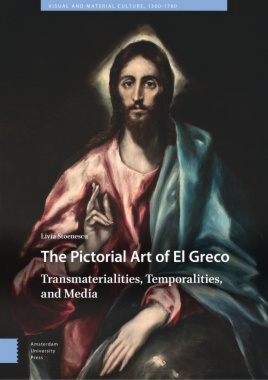The Pictorial Art of El Greco: Transmaterialities, Temporalities, and Media investigates El Greco’s pictorial art as foundational to the globalising trends manifested in the visual culture of early modernity. It also exposes the figurative, semantic, and allegorical senses that El Greco created to challenge an Italian Renaissance-centered discourse. Even though he was guided by the unprecedented burgeoning of devotional art in the post-Tridentine decades and by the expressive possibilities of earlier religious artifacts, especially those inherited from the apostolic past, the author demonstrates that El Greco forged his own independent trajectory. While his paintings have been studied in relation to the Italian and Spanish school traditions, his pictorial art in a global Mediterranean context continues to receive scant attention. Taking a global perspective as its focus, the book sheds new light on El Greco’s highly original contribution to early Mediterranean and multi-institutional configurations of the Christian faith in Byzantium, Venice, Rome, Toledo, and Madrid.
- Cover
- The Pictorial Art of El Greco
- Copyright page
- Contents
- List of Illustrations
- Acknowledgments
- Introduction
- Temporalities, Transmaterialities, and Media in the Pictorial Art of El Greco
- 1. Prototypal Images Reaffirmed in Early Modern Painting
- The Icon of Christ in the Pictorial Art of El Greco
- Theological Receptivity for Prototypes and the Enlightened Artist
- From Encaustic Technique to the Descriptive Brushwork of El Greco
- The Medium Integral to the Portrait of Christ
- The Referential Work of Federico Zuccari’s The Encounter of Christ and Veronica
- The Veil of Veronica in El Greco’s Pictorial Art
- Painting as a Mode of Veiling
- The Print as an Altarpiece Source
- Imitation in the Working Procedures of El Greco, Zuccari, and the
Carracci
- The Beauty of Holiness in a Novel Context
- 2. Spanish Miraculous Images, Sacred Narratives, and Aesthetic Goals
- A Marian Miraculous Image and the Aesthetic Goals of El Greco’s Portrait of St. Ildefonso
- Medieval Literary Sources
- The Virgin Apparition as a Statue and Ornamental Significance
- A New Relevance for Decorum
- Supernatural Images within the Religious Istoria
- An Enduring All’Antica Practice
- 3. El Greco’s The Purification of the Temple
- Venetian Architecture in El Greco’s Variations on The Purification of
the Temple
- The Temple of God in Painting: El Greco and Juan de Juanes
- Sacramental Meaning in the Saint Ginés Purification
- Renaissance Altarpiece Paradigms in Early Modernity
- El Greco’s Architectural Thought
- 4. Reinventing the Nude in an Age of Censorship
- A Novel Approach to the Nude
- Francisco Pacheco’s Positions on Decorous Imagery and Invención
- Dibujo Intrinsic to Ars in Pacheco’s Arte de la Pintura
- Santo Domingo Altarpiece and Inclusive Nude Portrayal
- The Santo Domingo Trinity
- Formal Analogies with the Pietà Theme
- Early Modern Critique of El Greco’s Trinity
- Saint John the Baptist from the Santo Domingo Retable
- Sculptural Quality and the Use of Borrones
- The Resurrection in Santo Domingo’s Context
- Counter-Reformatory Positions on Nudity
- Un San Jerónimo Desnudo
- El Greco’s St. Sebastian and the Artistry of Nude Portrayal
- Sensuous Depiction of St. Sebastian in the Counter-Reformation
- St. Sebastian Tondi
- El Greco’s Solutions to Nude Portrayal
- 5. The Dialogue of Classical and Devotional Cultures in El Greco’s Laocoön of Toledo
- Pictorial Allegory in El Greco’s Laocoön
- The Inventiveness of El Greco’s Laocoön
- Classical Antiquity in a Christian Context
- El Greco’s Laocoön of Toledo as a Paradigm of Exchange and Renewal
- The Creation of El Greco’s Laocoön in Toledo
- Pictorial Configurations in a Horizontal Format
- Narrative Prints of the Trojan Myth Translate into Pictorial Solutions
- The Engraver’s Ability to Disrupt Classicist Aesthetics
- Christian Humanism in Toledo
- Reform Ideas Reflected by El Greco’s Laocoön
- A Christian Laocoön
- Bibliography
- Primary Sources
- Secondary Sources
- Index

